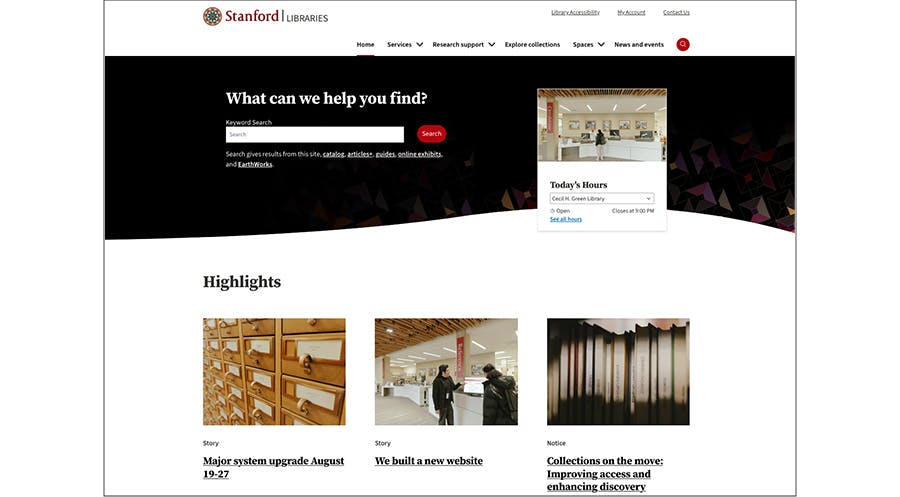New website launched

In conversation with Project Manager Cathy Aster and Editor-in-Chief Friederike Sundaram about the launch on July 31 of the new Stanford Libraries’ website.

Question: Why was Project Monarch chosen as the name for the design and implementation of the new Stanford Libraries’ website? What was its basic timeline?
The Project Monarch name was selected in 2021 to reflect an initial understanding that the new website would be a migration project. As Monarch butterflies migrate, the name felt appropriate. When further information was gathered about the new website requirements, it became clear that the content would not be migrated, and an entirely new website needed to be designed and created. The Monarch name stuck, however.

Project Monarch planning began in earnest in August 2021. In Fall 2021, Ellie Buckley was named as the project manager. Ellie managed the project through the end of the design phase, during which time the new website designs were vetted and approved by library leadership. In November 2022, Cathy Aster was designated as the project manager for the implementation phase. Cathy managed Project Monarch up through the day of launch, 31 July 2023.
Question: What are a few of the most noticeable improvements upon the previous website?
The content is presented in a much more user-friendly way. The Libraries have incredibly deep resources both in terms of staff expertise and collections. Our goal was to point users to the resources they want to explore further without overwhelming them with too much information up-front. We talk about the new website as a switchboard for users, and one that has accessibility at its center. The new website has undergone extensive accessibility reviews and we are continually educating ourselves to ensure access to our content is for everyone.
Question: How is the new website organized?
The new website is conceived of as a streamlined, accessible, and intuitive switchboard, based upon extensive user feedback that it was difficult to find things on the old library website. The switchboard is organized around the following pillars:
- Services: the things we do to help with research, teaching, and learning.
- Spaces: the physical and virtual spaces where these services are offered.
- Subjects: the areas in which our specialists collect resources to support users’ work.
- Collections: the physical and digital materials we have collected, organized, and made available to users.
- Research support: from subject guides, research consultations, and digital humanities workshops to data services, citation management, and scholarly communications, we are here to help at every step of the way along the research journey.
Question: How will the new website highlight the work of Stanford Libraries’ professional staff?
The website is constructed in such a way that for any library resource, whether that is a service, a subject, or a space, there are people associated with it who can be contacted by users for further assistance. Each page of the website features the expertise of often several library staff members. For anyone interested in our staff’s professional development and advancement of library science, we have begun a repository of staff publications, talks, and presentations.
Question: Who will continue to create content for the new website?
Staff members are invited to provide feedback, updates, and additions to the website to ensure that it grows and changes with the organization. We want a dynamic presence that provides fresh content reflecting the Libraries’ strengths and expertise in supporting the world-class research, teaching, and learning conducted at Stanford.
Question: May we join you in expressing congratulations and special recognition to the project team?
Eleven years have passed since Stanford Libraries last launched a new website, in summer 2012. The new website launched on 31 July 2023 was brought to fruition by a stalwart, tireless group of library staff including Ellie Buckley, Josh Capitanio, Kelly Fields, Ray Heigemeir, Pauline Lewis, Mario Pamplona, and Sarah Seestone, guided by Executive Sponsor Tom Cramer. Colleagues across the library contributed core content, providing feedback and helpful guidance along the way. Vital support from Stanford’s Office of Digital Accessibility ensured a quantum improvement in website accessibility. The website was built by an experienced team from Stanford Web Services.